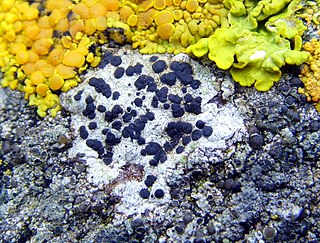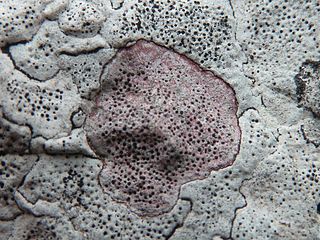
The Lecanoraceae are a family of lichenized fungi in the order Lecanorales. Species of this family have a widespread distribution.

Verrucariaceae is a family of lichens and a few non-lichenised fungi in the order Verrucariales. The lichens have a wide variety of thallus forms, from crustose (crust-like) to foliose (bushy) and squamulose (scaly). Most of them grow on land, some in freshwater and a few in the sea. Many are free-living but there are some species that are parasites on other lichens, while one marine species always lives together with a leafy green alga.

Porina is a genus of lichens in the family Trichotheliaceae. A 2020 estimate places about 145 species in the widespread genus.

Diplotomma is a genus of lichenized fungi in the family Caliciaceae. The genus has a widespread distribution and contains about 29 species. The genus was circumscribed by Julius von Flotow in 1849. It was later wrapped into Buellia before being segregated from that genus by David Hawksworth in 1980.

Dermatocarpon is a genus of lichens in the family Verrucariaceae.
Clavascidium is a genus of lichens in the family Verrucariaceae. The genus was circumscribed in 1996 by Austrian lichenologist Othmar Breuss. Because the type species of the genus, Clavascidium umbrinum, has been shown using molecular phylogenetics to belong to genus Placidium, Cécile Gueidan and colleagues proposed to unite Clavascidium with Placidium in a 2009 publication. Despite this, the genus has been retained in recent publications of fungal classification.

Bagliettoa is a genus of lichen-forming fungi in the family Verrucariaceae. The genus was circumscribed by Italian lichenologist Abramo Bartolommeo Massalongo in 1853. Bagliettoa species are endolithic, growing between the grains of solid rock.
Anthracocarpon is a genus of lichen-forming fungi in the family Verrucariaceae. The genus was circumscribed by Austrian lichenologist Othmar Breuss in 1996 with Anthracocarpon virescens assigned as the type species.

Placidium is a genus of crustose to squamulose to almost foliose lichens. The genus is in the family Verrucariaceae. Most members grow on soil, but some grow on rock (saxicolous). The fruiting bodies are perithecia, flask-like structures immersed in the lichen body (thallus) with only the top opening visible, dotting the thallus. Lichen spot tests are all negative. Members of the genus lack rhizines, but otherwise resemble members of the genus Clavascidium.

Placidiopsis is a genus of lichens in the family Verrucariaceae. The genus was circumscribed by Italian naturalist Francesco Beltramini de Casati in 1858, with Placidiopsis grappae assigned as the type species.
Involucropyrenium is a genus of lichens in the family Verrucariaceae. It has nine species. The genus was circumscribed by Austrian lichenologist Othmar Breuss in 1996, with Involucropyrenium waltheri assigned as the type species.

Heteroplacidium is a genus of lichen-forming fungi in the family Verrucariaceae. The genus was circumscribed by Austrian lichenologist Othmar Breuss in 1996 with Heteroplacidium imbricatum assigned as the type species. It was proposed as a segregate of Catapyrenium. Other morphologically similar genera are Neocatapyrenium, Placidium, and Scleropyrenium, although molecular phylogenetic analyses indicate that they are independent monophyletic lineages within the Verrucariaceae.

Porpidia is a genus of crustose lichens in the family Lecideaceae.
Arthopyrenia is a genus of fungi in the family Trypetheliaceae. It was formerly classified in the eponymic family Arthopyreniaceae, but molecular phylogenetics studies showed that the type species, Arthopyrenia cerasi, was a member of the Trypetheliaceae.

Leptorhaphis is a genus of lichens in the family Naetrocymbaceae. Members of the genus Leptorhaphis are commonly called birchbark dot lichens.

Pseudosagedia is a genus of corticolous (bark-dwelling) lichens in the family Trichotheliaceae. It was first circumscribed as a section of genus Arthopyrenia by Swiss botanist Johannes Müller Argoviensis in 1862. Maurice Choisy elevated it to distinct generic status in 1949. Pseudosagedia was little used until, in 1995, Josef Hafellner and Klaus Kalb resurrected the genus to contain members of the Porina nitidula species group with the perithecial pigment called Pseudosagedia-violet and lacking setae.

Catapyrenium boccanum is a species of squamulose (scaley), rock-dwelling lichen in the family Verrucariaceae. It grows on mortar or on calcareous rock. Its squamules are up to 4 mm wide, pale to dark brown with black margins and a black underside. Ascospores measure 11–15 by 5–8 μm. Because of its combination of squamulose thallus, simple ascospores, and lack of algae in the hymenium, this species is a "catapyrenioid" lichen, of which more than 80 exist in the Verrucariaceae.
Strangospora is a genus of lichen-forming fungi. It is the only genus in the family Strangosporaceae, which itself is of uncertain taxonomic placement in the Ascomycota. It contains 10 species.













